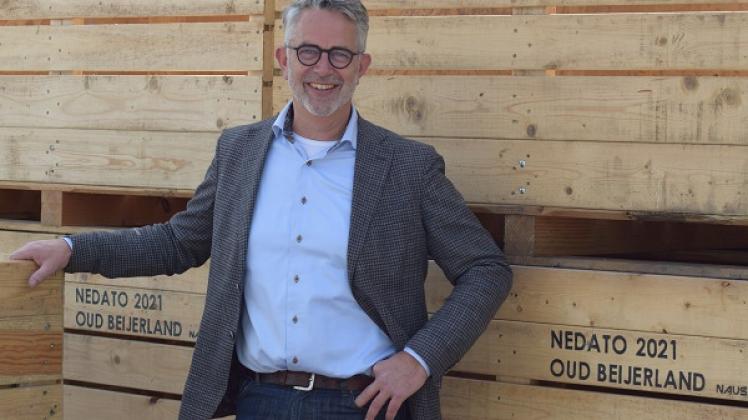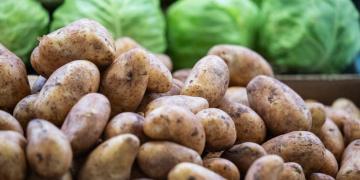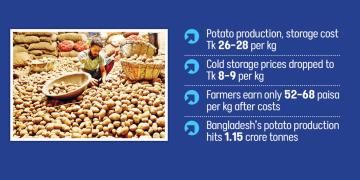Europa: Will high grain prices mean lower potato production?
Ukraine is considered Europe’s granary. At present, that country cannot export its stock, and Ukrainian farmers will sow hardly any grain. It is, thus, expected that growers in the rest of Europe, attracted by the high prices, will reserve part

"Still, the potato acreage hasn’t shrunk too much," begins Wim van de Ree, Dutch potato cooperative Nedato’s general manager.
"The war in Ukraine simply reinforces the factors that led to the Dutch potato area decreasing by six percent a year ago. That decline began in the spring of 2021 when potato growers reacted strongly to earning too little to cover increased production costs. They also face higher risks, like dry, hot, or wet weather. Indeed, in December 2020 and January 2021, industrial potato contract prices had fallen yet again - something growers were no longer prepared to accept. The chain’s profit margin distribution has become distorted."
Since the global pandemic began, not only diesel prices but those of machinery, parts, pesticides, and sprout inhibitors - especially since 2020, after CIPC was banned - have been steadily climbing. Confronted with falling contract prices, Northwest European growers decided to plant fewer potatoes. In 2021, that was six percent less of approximately 27 million tons.
In Northern France, growers opted for winter wheat
"Prices rose for a second time when, in August last year, the economy began recovering, and demand in all sectors soared. The whole world needed transport resources and energy, but scarcity in those markets caused prices to climb, which, in turn, pushed up the prices of all types of raw materials. In September/October, growers could still choose to sow winter wheat instead of keeping the lots for potato cultivation. Many growers, especially in northern France, saw more benefit in wheat at that time," Wim continues.
French fry companies raising contract prices
As a result, in addition to the previous year’s decline, 2022’s potato acreage is under pressure. "French fry company managers began worrying about raw material availability. That’s new to them because, for years, there had always been an oversupply. They decided to raise contract prices to encourage growers to plant potatoes. That €0.03 to €0.04 more translates to a 20-25% increase; something that can safely be called unprecedented.”
“The plan worked reasonably well. At those prices, many growers were willing, but certainly not very happy, to plant ware potatoes. But then Russia invaded Ukraine. The diesel price rose to €2.60/liter, and fertilizer prices skyrocketed. That initial increase in contract prices no longer suited the new situation. And growers still had time to choose summer grains or corn instead of potatoes, which several did," Wim explains.
Shift to fry potatoes
Given Nedato’s seed potato figures and those it gleaned from other companies, Wim thinks the Dutch 2022 potato acreage will be, at best, the same as last year’s; it could even shrink a bit more. "That means 94%, or less, of 2021’s area. But things are changing. In the north of the country, for instance, growers will cultivate more fry potatoes at the expense of starch potatoes, and in the southwest, you see the same trend, but at the expense of seed potatoes. Export potatoes, too, are losing out in favour of french fry production. These aren’t staggering numbers, of course, but it seems growers are using more acreage for fry potatoes."
Corn farming is more profitable
Wim, however, immediately comments on this finding: "In Belgium, several smaller companies, who normally lease their land to potato growers, now seem to be planting corn on those plots themselves. That’s partly due to a change in Belgian subsidy regulations - the lessor, not the lessee, must apply for and therefore receive grants - and partly because corn yields currently outweigh the rental property income. That affects what is happening in parts of the Netherlands, where less land is available for potato growers. So, famers choosing to grow corn in those areas negate the positive trend of more fry potato hectares in the North and Southwest of the Netherlands."
Chain margin redistribution needed
It, thus, seems that, for the coming season, the potato market’s dynamic will be well balanced between supply and demand. None of the previous years’ overproduction is expected. That forms a basis for a healthy market and is a good starting position for growers. "That’s good news. Hopefully, the chain’s margins can now be redistributed. But that means processing companies, as well as the consumer market, will have to follow that narrative. I’m hopeful because this is slowly happening already. Store prices for pre-fried French fries are already rising. It seems people have realized that growers have to enjoy some of the profits."
Contract prices update
According to Wim, August and September will be another crucial period for the potato market. "Then, northwest European farmers must decide between sowing winter wheat or keeping the acreage for potatoes. And that time is almost upon us, just after the 2022 harvest. Potato buyers will feel pressured into sharing what 2023 contract prices might be, something that usually only happens at Christmas. If wheat prices remain good, many growers will be tempted to sow winter wheat soon. And the french fry industry could end up in a real raw material shortage situation. We could expect a further contract price update in September."
High food prices might spell bad news for Joe Public, but that shows it is time for food production to get back to the top of the agenda. The production and market disruption in Russia and Ukraine are massively affecting food production and supplies worldwide. People must refocus their attention on actively supporting the actors who meet their primary needs. And that inevitably means valuing the sector that feeds the world. "Food production’s importance is back in the picture. That, at least, is a bright spot in these dark times," concludes Wim.
Wim van de Ree
wvanderee@nedato.nl
Nedato
info@nedato.com
Fuente: https://www.freshplaza.com/article/9431525/will-high-grain-prices-mean-lower-potato-production/




